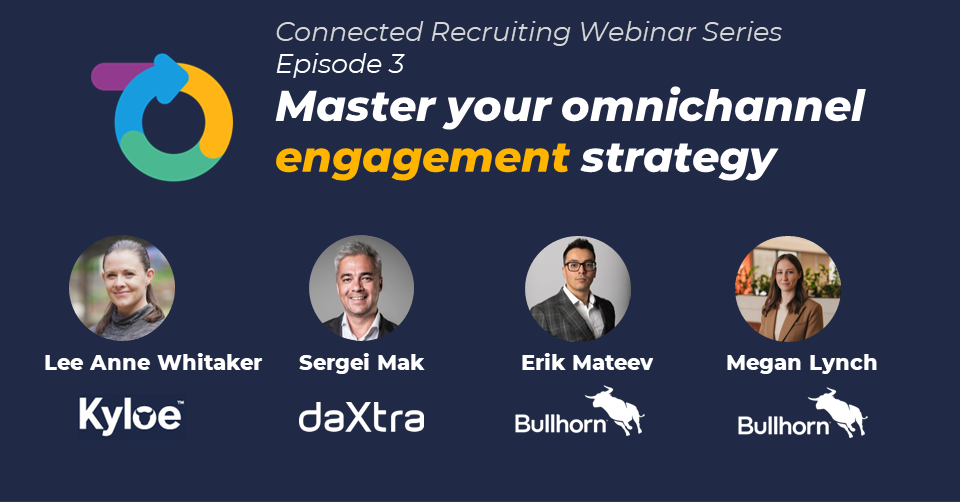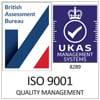In today's work environment, keeping your talent pool engaged is crucial for staffing agencies to stand out. But how can you create a personalised and scalable talent community?
Connected Recruiting, developed by Bullhorn, is a strategy designed to help recruiters engage with talent throughout all stages of the talent lifecycle. It comprises four key stages: Attract, Engage, Onboard, and Nurture. This approach involves using technology effectively alongside the right engagement methods and industry-proven techniques to change how your team interacts with candidates and clients. In this webinar, experts from the recruitment industry explore the Engage phase of the Connected Recruiting talent lifecycle.
Hosted by Erik Mateev, Strategy Manager of Automation & AI at Bullhorn and Megan Lynch,
Global Account Specialist at Bullhorn, the panel featured Bullhorn Marketplace Partners, Sergei Mak, Founding Partner at Daxtra and Lee Anne Whitaker, COO & CDPO of Kyloe Partners and focused on understanding your audience. Do you have enough information about all the candidates in your database to deliver the appropriate message, at the right moment, through the right channel, for the right job opportunity?
Where we are today
Bullhorn recently analysed 7.8 million Placement Records across their data centres. Surprisingly, they discovered that over 70% of these placements had a Candidate Submission source not listed as a Bullhorn Database Search. What's even more striking is that among these externally-sourced candidates, 66.4% were already present in the database. This led to the unnecessary expenditure of paying to acquire the same candidates a staggering 3.6 million times.
Based on these findings, it's clear that we need to change how we think about our ATS (Applicant Tracking System). Instead of seeing an ATS as a simple record-keeping system, we need to start to shift toward a community-oriented approach. This means creating engagement plans for all candidates already in our system, no matter where they are in the process. By doing this, we can maintain regular communication, keep up-to-date information, and ensure the best candidates are matched with the right job opportunities, reducing the duplication of effort.
What are the challenges?
For many of the speakers on the panel, they find that a lot of their clients have a good high level idea of what the future state looks like but not the journey, technologies and processes to get there.
Lee Anne Whitaker from Kyloe Partners shared that, “It can be very easy to think about the client and candidate experience but what about your recruiters - your internal staff? We are hearing the words, ‘change management’ more than ever, so the real challenge is applying your processes into your business and taking your staff on the journey.”
When it comes to your engagement strategy, there is much to consider. How good is the data you have in your CRM (Candidate Relationship Management system)? What candidate data strategies do you have in place to keep it accurate and up to date? In this growing space of automation, your candidate data strategy will define the success of your business.
What is your data strategy?
One of the biggest barriers to a more efficient recruitment process comes down to data hygiene issues - which can often be neglected. The database is only as good as the quality of data within it. Companies who do not prioritise maintaining high-quality data end up relying excessively on external paid sources to discover suitable candidates.
Sergei Mak from Daxtra shared some statistics that support this. “Our findings suggest that an average recruitment firm fills only around 10-15% of their roles with candidates that they find in their in-house database. The rest are either candidates responding to advertised jobs, or candidates found by searching external data sources.”
In modern recruiting, it's common for recruiters to post job openings on various online platforms and then passively wait for responses. Unfortunately, even though modern CRM systems are sophisticated, feature-rich, and highly capable, they are frequently used primarily as costly order processing and tracking tools instead of being used to actively assist in candidate sourcing.
If recruiters rely too heavily on external sourcing, it will have a detrimental impact on the business, leading to a substantial waste of resources. Each application from a job board typically comes at a cost of approximately $10 to $15, not including all the additional expenses of creating and publishing ads, sifting through the responses, and more.
Sergei Mak went on to give more insight, stating that, “60 to 70% of candidates that apply to you are already in your database. We know that for a fact because we can accurately report on the number of times we update an existing record on Bullhorn vs the number of times we create a new candidate. So for every 1000 candidates applying to jobs, seven to 10 thousand dollars can be saved if you communicate regularly with the candidates in your database, and if the database is used as your primary source of talent.”
This is why automation is crucial. Typically, about 80% of candidates in the system are out of date and disengaged. In a manual process, it's impossible to engage with every candidate and maintain database health, you need technology to support you. Then, when you consider the candidates in your second-largest talent pool (after the 80% who are disengaged), some may be engaging with you and interacting with your content, but their information is still out of date. Your smallest talent pool consists of your most recent candidates, and these are the ones you can actually work with. But, without consistent engagement - keeping in touch and periodically requesting that they update their information - they too might become part of that growing pool of disengaged and out of date candidates. So - you need a solution to address this issue.
The strategies and best practices you should use
How to clean and enrich your database
Begin by cleansing and enriching your existing database. Identify the right parsing tools that can help you automate this process, allowing you to add new skills and populate missing fields. An automation tool such as Daxtra Capture can also identify clusters of duplicates for you to review and merge, and also automatically upload and deduplicate all of your incoming applications.
Megan Lynch, Global Account Specialist at Bullhorn, highlighted that, “Though having a healthy pool of up-to-date data is valuable, ensuring active engagement is equally critical. Automating this aspect is vital because most recruiters are swamped with their tasks and don't have the time to actively approach passive candidates or check their interest in receiving emails. By automating these engagement efforts in the background, candidates remain engaged and ready for interaction when recruiters do need to reach out. This can significantly improve the recruitment process.”
You can leverage Bullhorn's automation capabilities to contact inactive and outdated candidates in your database and request updates from them. Some may choose to opt out, indicating they no longer need updates, and they can be automatically marked as inactive in the database. The candidates who respond will be automatically updated.
How to improve your engagement strategy
Start by establishing your candidate engagement strategy. You should review the current flow of candidate data through your business, including everywhere you’re getting information from the candidate. Look for anywhere you can infer the data based on actions the candidate has taken such as applying for a job, or a placement you’ve made. Then you can identify opportunities for automation to enhance the data. Before delving into when and where to prompt your recruiters for data input along the candidate journey, prioritise identifying the specific information you need from candidates and validating existing data.
Lee Anne Whitaker from Kyloe Partners echoed this by advising that you, “Map this engagement strategy onto your current Bullhorn system and process. The gaps you discover will allow you to then build and implement the best automations including data updates, internal and external notifications, and surveys to capture and continually keep your candidate data up to date. Ask yourself - where are we and what does good look like?”
Once you have this strategy in place, the full potential of Bullhorn Automation can come into play. It can actively engage your passive candidates, nurture your existing ones, follow up with candidates in your active recruitment cycle, and ensure compliance with your business data requirements.
Erik Mateev, Strategy Manager of Automation & AI at Bullhorn added to this by emphasising how important it is to, “Invest in an internal cross-functional team, particularly for larger recruitment agencies. Within your organisation, various individuals will have different concerns and distinct objectives, spanning departments like Operations, Marketing, and more. Failing to engage the right team members in your automation strategy could mean missing out on crucial elements that can greatly benefit the entire business.”
How to measure success
Determine your definition of success and establish KPIs (key performance indicators) to measure and report on it. These KPIs could be based on factors such as the number of up-to-date resumes, the percentage of candidates who have been engaged, or the number of follow-up calls to candidates during a recruitment cycle or thirty days post placement. Share this information internally so that everyone is aligned on the goals they're working towards. Success metrics can vary between businesses, reflecting their unique work approaches, values, and mission statements. By using Bullhorn's Analytics, Reporting and Automation dashboards, you can measure whether you’re being successful and, if not, look at what you need to change to achieve success.
Also, keep in mind that in this ever-evolving world, you need to be constantly tweaking and enhancing your strategy. With numerous competitors and emerging technologies out there, it's crucial to regularly assess the metrics and strategies you've implemented to check that they're still working for your business. This is an ongoing engagement strategy, so you must continuously develop and adapt to maintain a leading position.
How to encourage your team to have a ‘database first’ mindset
In essence, the key is to restore trust in your ATS among your recruiters. As you develop these strategies and map out candidate engagement plans, communicate this message to your recruiters so they understand the efforts being made and can witness the positive results. This process will eventually lead them to prioritise the use of your database as their primary resource.
Furthermore, allocate resources to provide additional education to your recruiters so they fully grasp the significance of this shift. Sergei Mak suggested, “Companies need to invest some effort into change management and education to get their recruiters to understand the value of this and implement KPIs to manage it, such as looking at the source for placed candidates.”
It's not only about them understanding how to use the tools but also why it matters. Lee Anne Whitaker highlighted that you need to, “Look at not just how but why. What’s in it for your recruiters? What benefits does it bring to your team? They need to buy into that bigger picture of what it means for everyone in the business to have that ‘database first’ and data quality mindset.”
Once you achieve this, you'll have advocates within your team who can actively drive the ‘database first’ mindset. They will understand the strategies needed and how to implement them effectively to attract more candidates.
What’s the next big thing in recruitment?
Embracing emerging technologies
There’s recently been an explosion of new technology. We now have a multitude of options available, including specialist systems and add-ons, with so many platforms now saying they’re built on AI. This is expected to grow in the future, and will fundamentally reshape the role of recruiters. This transformation, however, is likely to bring about positive changes by enabling recruiters to become more efficient and further reducing the burden of mundane and repetitive tasks.
Companies that embrace this evolving landscape will benefit most, but staying informed and ahead of this technological curve will be the most challenging aspect. This is why it’s crucial to recognise that everything you use, both inside and outside of your Bullhorn system, is a part of the ecosystem of your business.
In this complex ecosystem, it's essential to explore a diverse range of tools to find the ones that align with your specific business needs. Don't hesitate to adopt multiple tools that seamlessly integrate with any system, including Bullhorn’s, and prioritise seeking support from consultancies and experts that are well-versed in this domain to help guide you on the path to success.
Enhancing the value of the human element
Lastly, after implementing all these automations and leveraging the appropriate technology, don't forget to re-emphasise the human connection element. This is what sets your recruitment agency apart and makes it exceptional. Let technology do the heavy lifting in your business - handling the administrative tasks so that you can concentrate on applying your expertise to connecting effectively with candidates and clients.



